In the shallow waters of Lake Tanganyika, you can find seemingly nondescript fish that live in empty shells of gastropods. These are none other than lamprologus – miniature cichlids of the Great Lake of Africa, which have become popular aquarium inhabitants but not only for their appearance, but also for their unique forms of behavior. So why are these fish interesting? You will learn this from our article.
General information
Lamprologus is a group of freshwater tropical fish from the Tsichlov family? Endemic to Lake Tanganyika in Africa. Includes 4 genera: lamprologus, neolamprologus, altolamprologus, and lepidolamprologus. But, despite the different systematic position, all species are traditionally called simply “lamprologus”.
Most aquarium lamprologus belong to the group of so-called “shells”. This reflects an interesting feature of their ecology. The life of these fish is closely related to the empty shells of gastropods, mainly from the genus Neothauma. Shells serve as natural houses for apologists, where they hide from enemies and raise offspring. At the same time, the fish leave their home only when it becomes crowded in it and go in search of a more spacious home. Some individuals try to take the “house” away from their relatives. The occupied territory – the shell and the adjacent area of the bottom – are zealously protected by the fish.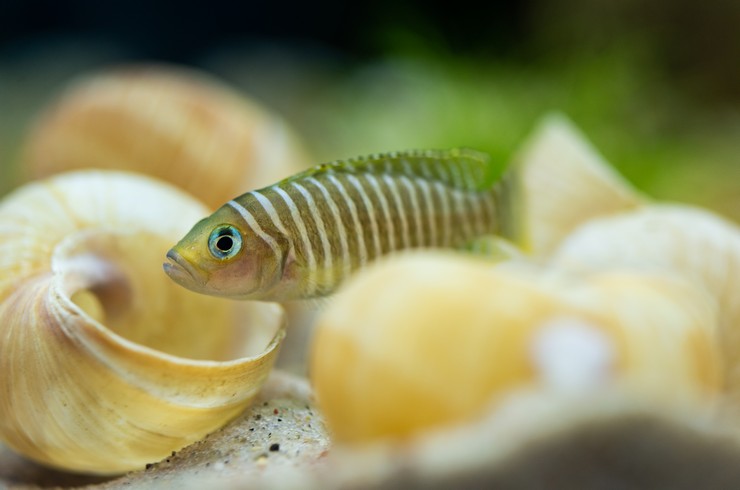
In general, the fish are picky about the care and get along well with live plants. And the modest size of many of them allows keeping species of this genus even in small aquariums.
Appearance
The lamprologus group is very diverse in terms of appearance. The largest representatives do not exceed 12 cm in length, and the usual size of shell lamprologus is 2-4 cm. The latter are not distinguished by their bright colors, they are inconspicuous and presented in pastel colors. Some types of lamprologus are painted in rather bright colors. A typical example is an orange lamprologus with a rich yellow-orange color. There may be glowing spots and transverse stripes on the body.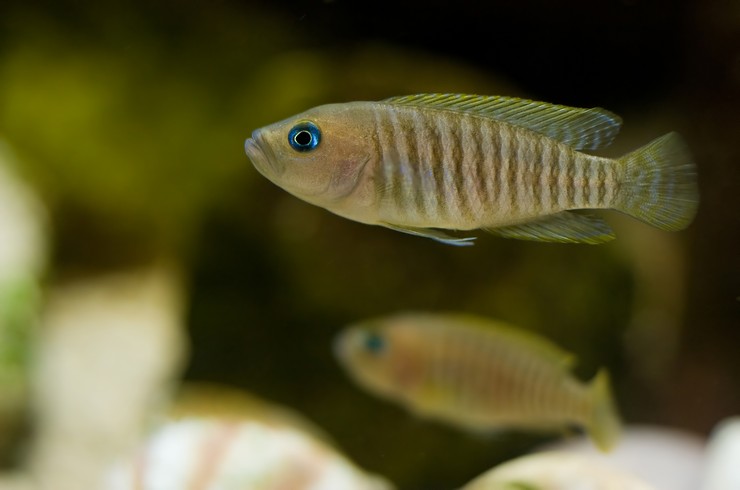
The shape of the body is elongated. All lamprologus have a dorsal fin extending from head to tail. The caudal fin is single-lobed, trapezoidal, or rounded. Seashell lamprologus have disproportionately large protruding eyes, which is why they are often called “frogfish”.
Habitat
Lamprologus are predominantly endemic to Tanganyika, the second largest lake in Africa. It is of tectonic origin and is the longest freshwater lake in the world and the second deepest after Lake Baikal.
They prefer coastal shallow waters with sandy soil and stones, although some species live at great depths. For shell lamprologus, the presence of empty shells of gastropods plays an important role. In places of accumulation of shells, these dwarf cichlids arrange whole “cities”, where everyone lives in their own shell house.
Some species are found in the Congo River. They lead a gregarious lifestyle.
Care and maintenance
The aquarium for lamprologus should be selected depending on the maximum size of the fish. Small shell lamprologists will need a capacity of 40-60 liters. For large representatives, it is better to get an aquarium from 100 liters. It is desirable that the bottom area be maximized.
It is best to choose sand with a fraction of 0.5-1.5 mm as soil, poured into a layer of 5-6 cm. As decor, you can install driftwood and stones. For shell lamprologists, be sure to ensure that there are empty shells in the shellfish. Pretreated shells of the large ampulla, grape snails, and Achatina can be used. Shellfish shells can be too heavy for lamprologus, so they are best avoided.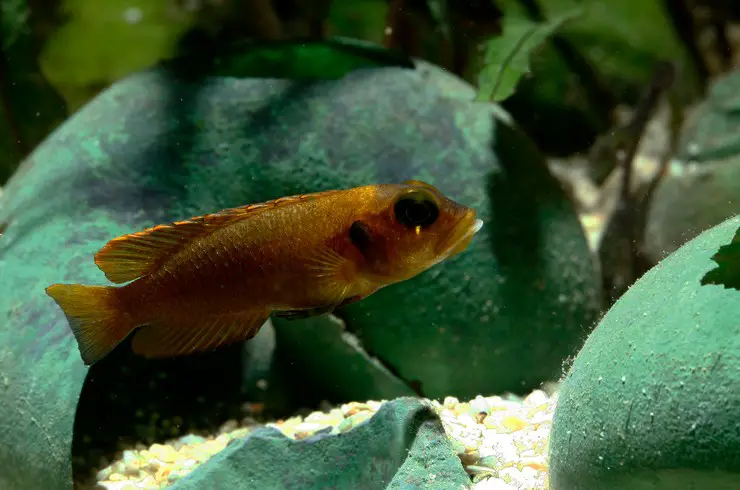
In aquariums with lamprologus, you can plant live plants, because these cichlids show little or no interest in them. However, it is better to give preference to those species that tolerate hard water well: Vallisneria, Cryptocoryne, Echinodorus.
Lampologus are sensitive to the content of nitrogenous compounds in the water, therefore it is important to install a high-performance filter, compressor and carry out regular water changes – up to 20% of the volume of the aquarium weekly. The current should not be very strong, and the lighting should not be intense.
Compatibility
Like many fish of the African Great Lakes, lamprologus are famous for their territoriality. Males are especially intolerant of each other. Therefore, in most cases, it is recommended to house one male and several females together, especially if the volume of the aquarium is small. Dwarf shell lamprologus, with sufficient volume, can be kept in flocks of 8-10 individuals. But it is necessary to provide them with a sufficient number of shells.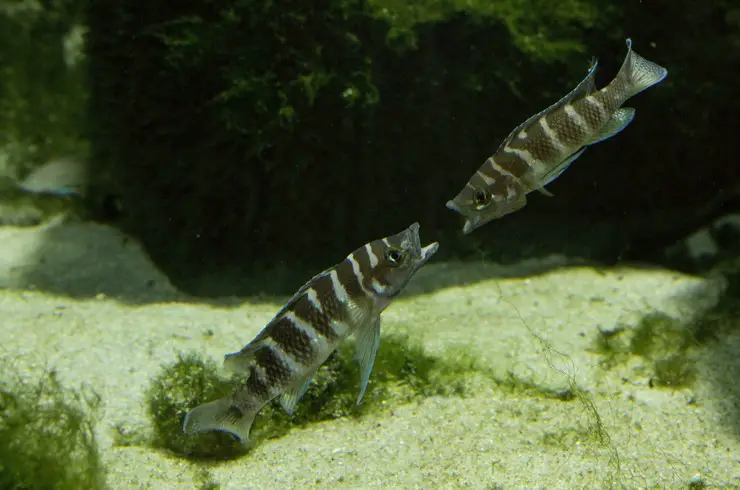
Good neighbors for lamprologuses will be pelvicachromis, apistograms, hypochromic, yulidochromis, and other lamprologus.
These fish can get along well with large barbs, labels, bouts, macropods. But here it is important to observe the behavior of the fish in order to take timely measures in case of conflict.
Do not plant large aggressive fish together with lamprologus.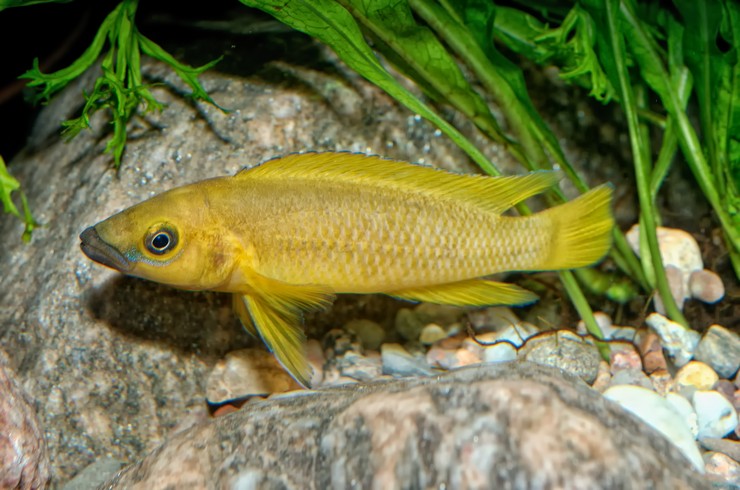
Feeding lamprologus
Most lamprologus prefer protein foods. In nature, fish feed on insect larvae, small crustaceans, and worms. In the aquarium, this food is excellently replaced by high-quality dry food. Unlike live and frozen food, they are balanced, fortified with vitamins, and cannot become a source of infection.
Lamprologus food should be high in protein and sink quickly to the bottom because fish prefer the middle and lower layers of the aquarium.
Good choices are:
- Tetra Cichlid Granules and Tetra Cichlid Mini Granules are the staple food for all mini to medium-sized cichlids. Fully satisfy the nutritional needs of carnivorous fish.
- TetraMin Granules is a universal basic food for all tropical fish. Contains vitamins and prebiotics to support your pets’ health and longevity.
- And so that the hunting instincts of lamprologus do not fade away, indulge them with natural delicacies in a nutritious jelly from the Tetra FreshDelica series.
Reproduction and breeding
Breeding lamprologus at home will require some experience. It can be difficult to find a pair. In some lamprologus, if a female, not yet ready for spawning, is launched to a pubertal male, the male can kill the female. After all, males of certain species become very aggressive during the spawning period. Better to plant small schools of young fish in the aquarium and let them pair off on their own. Puberty occurs at the age of 10-14 months.
For maximum survival of the fry, it is recommended to plant the pair in a separate container, this will also help to protect the neighbors in the common aquarium from the attacks of the male.
Caviar is usually deposited on various substrates – ceramic grottoes, stones, pots. Fertility can range from 20 to 100 eggs.
Incubation lasts about 3 days, then for another week the fry feed on the yolk sac.
Especially interesting is the process of reproduction in the shell lamprologus. They lay eggs inside their shells. In this case, the female is engaged in attracting the male. Caring for caviar and fry also falls on the shoulders of the female. The development of eggs after fertilization and before the fry emerges takes about 10 days. At first, the babies stay with their mother and, at the first sign of danger, hide in the sink.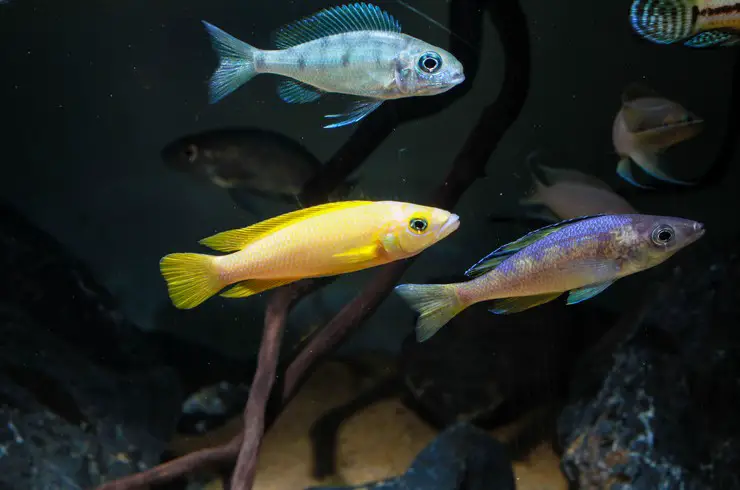
At the age of about 1.5 months, almost all fry blur and find their own home, but some stay with the mother and help her to raise new offspring.

